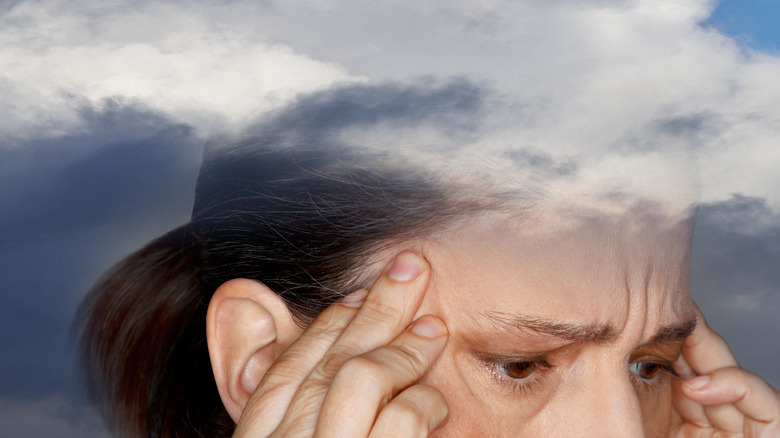Symptoms Of Lupus You Shouldn't Ignore
Imagine you're baking a chocolate cake. In all likelihood, you're following a recipe — even if it's just on the side of a box of cake mix — and you know that if you remove any one ingredient, you won't end up with the precise type of cake you're trying to make. In other words, certain ingredients always equal your chocolate cake. However, certain symptoms don't always equal lupus.
As the Mayo Clinic explains, lupus is a type of autoimmune disease. This means that the immune system mistakes different parts of the body for a threat and attacks those parts the same was it would a dangerous virus or strain of bacteria. These attacks cause inflammation that can affect everything from a person's skin and joints to the parts of their circulatory system (like the heart, blood vessels, and blood cells). Other areas lupus can negatively impact are organs like the lungs and kidneys, as well as the brain and nervous system.
Although we understand that lupus can cause inflammation throughout the body, that doesn't mean every person who has lupus will experience the exact same symptoms, per Mayo Clinic. With that said, we know there are certain symptoms that can be red flags of lupus. And being aware of possible symptoms of this disease means you're more likely to recognize a potential health problem and seek medical help.
Facial rash
What's the first thing that pops in your mind when you hear the word butterfly? Maybe it's how spring has arrived, since they're emerging from their cocoons. Or perhaps, it's how beautiful their colorful wings are in photographs or when recreated on clothing and jewelry. Yes, there are many positive associations with butterflies — but for some lupus patients, the word butterfly can remind them of a symptom of their disease.
According to the Centers for Disease Control and Prevention (CDC), there are different types of lupus, and one of the most common is systemic lupus erythematosus (SLE). This form of lupus affects multiple areas of the body, including the skin. And as WebMD explains, SLE can cause a type of facial rash known as the butterfly rash, since the way the rash covers a person's nose and cheeks creates a shape similar to a butterfly. This skin condition is also called the malar rash or malar flush.
So, if you have a malar rash, you automatically must have lupus, right? Actually, that's not the case. While it's estimated that around 50% of lupus patients develop butterfly rashes, they can also occur because of certain bacterial skin infections, low levels of vitamin B3, and other medical conditions like rosacea (via WebMD). However, if a health care professional determines that lupus is the culprit behind a malar rash, then they will probably advise limiting sun exposure, and might treat the rash with oral medication, topical creams, and/or steroid injections.
Brain fog
Now before you panic, there's many reasons why a person might feel a bit foggy. Both stress and not getting enough sleep — or worse, a combination of the two — can leave you feeling less sharp than normal. But as the Lupus Foundation of America points out, brain fog happens to anywhere from 70 to 80% of lupus patients.
Just as people with lupus can experience different symptoms, lupus patients can experience brain fog very differently. One person with lupus brain fog (or what's sometimes called "lupus fog") might have a hard time concentrating and/or thinking clearly. Someone else with lupus fog, however, might constantly forget things. And still someone else could have problems communicating because they struggle to find the word they want to use. Additional, possible lupus fog symptoms include having a harder time solving problems, difficulty with multitasking and making plans, confusion, and read issues where they need to read something more than once.
Even though lupus-related brain fog can be disruptive, there are simple ways to help manage it. For example, keeping notes and lists can help with memory problems caused by lupus fog. Also, don't be reluctant to schedule more time to do something or compartmentalize tasks rather than trying to do more than one thing at once. As long as you accomplish what you want to and need to, it's okay if you take a slightly different approach to get there.
Joint pain
It's easy to focus on how lupus can affect one's organs. After all, if something goes wrong with someone's heart or lungs, there can be deadly consequences. However, it's important to remember that lupus can affect many areas of the body, including the joints. In fact, the Lupus Foundation of America notes that the majority of lupus patients experience issues involving the bones, the joints, or the muscles. And unfortunately, joint pain caused by lupus can lead to other health issues.
Not only can a person with lupus experience joint pain, but they also can develop inflammation in their joints and the areas around their joints. And this can be the perfect storm to cause other inflammation-related problems, such as arthritis. After all, arthritis is inflammation in the joints, and a person with lupus is more likely to experience arthritis in specific areas of the arms and legs. So, if someone has arthritis in their elbows, knees, or ankles, that could be a red flag of lupus. Then again, a different person with lupus could have arthritis in their wrists, fingers, and toes.
Besides arthritis, lupus that causes joint pain and problems can also lead to tendonitis which, as its name indicates, impacts the tendons typically in the shoulders, elbows, and fingers. Additionally, lupus-related joint issues can cause carpal tunnel syndrome, a condition that can impact the wrist, hands, and fingers.
Shortness of breath
If you look up shortness of breath, you'll see it can be a symptom of a number of health issues. As a matter of fact, it's not only a possible symptom of lupus, but it can also be a sign that lupus could be directly or indirectly affecting more than one area of someone's body. For example, a lupus patient who experiences not just shortness of breath but also pain when they try to take a deep breath might have inflammation in the sac that is around their heart (via Lupus Foundation of America).
Additionally, someone with lupus is more likely to develop another immune system-related health problem, antiphospholipid syndrome or APS, according to the Mayo Clinic. When this happens, a person is more likely to develop blood clots, which can obstruct the blood vessels that circulate blood to the lungs (per Lupus Foundation of America). This condition is known as a pulmonary embolism and can cause shortness of breath. In addition, blood clots can cause a heart attack or a stroke.
Furthermore, a lupus patient could develop a couple of different types of inflammation related to their lungs. One is pleuritis, where the tissue that covers the lungs becomes inflamed. The other is pneumonitis, which usually occurs because of an infection (as opposed to lupus directly). However, someone with lupus is more susceptible to the condition. And yes, shortness of breath is a symptom of both pleuritis and pneumonitis.
Mouth sores
Unfortunately, lupus and skin problems can go hand in hand (via Family Medicine Austin). And some might be more noticeable to the outside world than others. For instance, sometimes someone with lupus will develop a butterfly-shaped rash on their face, per WebMD. However, just because a change in one's skin isn't as noticeable, doesn't mean it can't be a warning sign of lupus.
According to Family Medicine Austin, lupus patients can experience a couple of different types of mouth sores or ulcers. One is white with a red outline and, despite being called a sore, is usually not painful. The other is the inverse, both in terms of appearance (being red with white lines around it) and because it's usually painful. And while lupus mouth sores can occur in different places for different patients, they most commonly happen in three spots: the hard palate, the inside of the cheeks, and the lower lip.
Like other symptoms on this list, not everyone who has lupus will develop any type of mouth sore. However, there are certain factors that can increase the chances of them developing. A person who is both stress and overworked, and has an extremely common form of lupus called systemic lupus erythematosus or SLE, is more likely to develop mouth ulcers. Also, dental concerns like a chipped tooth, dentures that don't fit properly, or damaged gums can all up a lupus patient's chances of having mouth sores.
Hair loss
Imagine this scenario: You're having lunch with a friend who confides in you that they've been losing their hair. They're unhappy but not overly concerned, since hair loss runs in their family. Except they're also noticing lesions on their scalp. Unfortunately for your friend, that combination could be a red flag that they have lupus.
According to the Mayo Clinic, not only is hair loss a possible symptom of lupus, but it can also be one of the first ones somebody experiences. How the hair loss happens can vary from person to person. One lupus patient might find their hair slowly becoming thinner, while another patient might experience clumps of hair falling out. A person with lupus might also have weaker hair along their hairline, which can impact the hair's appearance. And even though most people focus on losing the hair from the top of the head, lupus-related hair loss can also occur on other areas of the head, like the eyebrows and eyelashes. Someone who could previously grow a beard might not be able to after developing lupus. In addition, hair loss can also affect other areas of the body besides the head.
The good news is that it's possible to grow back hair that's lost because of lupus (via Healthline). However, if a person also develops round lesions on their scalp, that can damage the hair follicles (per Mayo Clinic). And once that happens, the hair loss becomes permanent.
Dry eyes
The expression "there wasn't a dry eye in the house" refers to when an actor gives a great performance that moves the audience to tears. However, even when you're not crying, your eyes aren't technically dry. Nor is there no moisture at all in them if you have "dry eye syndrome," a condition where inflammation interferes with the natural moistening of your eyes (via the Hospital of Special Surgery). And yes, lupus, which causes inflammation, can be the culprit behind dry eyes, but to really understand the connection between lupus and dry eyes, we need to talk about Sjogren's syndrome.
Like lupus, Sjogren's syndrome is an autoimmune disease (per the Hospital of Special Surgery). But while lupus can affect a wide range of areas of the body, Sjogren's syndrome only affects two types of glands: the glands responsible for producing saliva, and the glands that keep your eyes moist. Sometimes, a person will experience just Sjogren's syndrome, but it's also possible for this condition to happen with another disease, like lupus. In fact, up to 30% of lupus patients have Sjogren's syndrome — a big jump from the stats for the general population (1-3%).
Of course, there are medications on the market that can help manage lupus. But as Dr. Sergio Schwartzman said at a Hospital of Special Surgery workshop on systemic lupus erythematosus (SLE), certain medicines used to treat lupus like immunosuppressant agents can have a negative impact on the eyes.
High blood pressure
Did you know that not all numbers above a normal blood pressure reading are classified as high blood pressure? The National Heart, Lung, and Blood Institute states that normal blood pressure is usually below 120/80 mmHg, with low blood pressure being a reading that's under 90/60 mmHg. Depending on the health care professional, high blood pressure can be diagnosed at either 130/80 mmHg and higher or 140/90 mmHg and higher (via CDC). Wwhen it comes to lupus, it's very common to have blood pressure readings that are not only above 120/80 mmHg, but also diagnosed as high blood pressure (per Johns Hopkins).
Lupus can have a negative impact on your heart and blood vessels, and can also hurt your kidneys. It's quite common for someone with lupus and kidney disease to develop high blood pressure. Additionally, two medicine types prescribed to lupus patients (steroids and cyclosporine) can also raise blood pressure. Furthermore, if a person has lupus and is also obese, that can affect blood pressure as well.
To be fair, when someone is working to manage an autoimmune disease, high blood pressure might seem like the least of their worries. But having high blood pressure today can mean heart and/or kidney failure tomorrow. Also, a person with high blood pressure is more likely to have a heart attack or a stroke. And statistically, cardiovascular disease is responsible for the majority of lupus patient fatalities.
Swollen lymph nodes
The phrase "full of beans" is sometimes used to describe someone who is full of energy. However, in a way, everyone is literally full of beans — or rather, bean-shaped glands called lymph nodes (via WebMD). That said, it's a good thing lymph nodes are located in so many places in your body, because they have immune cells that help fight off dangerous foreign invaders like viruses and bacteria. And of course, sometimes you need more immune cells to defend your body against an illness or infection, which can cause the lymph nodes to become swollen.
Okay, but what does any of this have to do with lupus? Well, lupus is an autoimmune disease, which means a person with lupus can experience issues with their immune system. So, a person with lupus can experience swollen lymph nodes. As a result, you might notice painful or tender bumps in areas like where your legs attach to your torso, under your arms, and on your neck. And while the size of these bumps can vary, sometimes they're approximately the same size as a kidney bean.
Although lupus can cause swollen lymph nodes, so too can other medical conditions like Lyme disease, leukemia, tuberculosis, and HIV/AIDS. So, regardless if you have lupus or not, there are certain warning signs to seek medical help right away for swollen lymph nodes. These include if they're very swollen, hard, or warm.
Fatigue
In the Looney Tunes cartoon "Transylvania 6-5000," a vampire encourages Bugs Bunny to fall asleep inside his castle. Bugs admits that he is "fatty-guewed," which is his attempt at phonetically pronouncing the word "fatigued." Mispronunciation aside, however, Bugs wasn't actually fatigued. At most, he was overly tired (or as the Mayo Clinic puts it, temporary fatigued), but it was nothing that a little rest wouldn't fix. But being truly fatigued doesn't just disappear with a quick nap. And according to the Lupus Research Alliance, there's data suggesting that lupus patients are more likely to experience fatigue.
As the Alliance notes, a study in the British Journal of Dermatology measured "clinically significant fatigue" in people with several different types of autoimmune diseases, including two types of lupus: systemic lupus erythematosus (SLE) and cutaneous lupus (i.e. skin lupus). The study also involved a group of people with no autoimmune diseases. The results showed that more people with either of the two forms of lupus had clinically significant fatigue than the other groups. In fact, 44.2% of the SLE patients' group and 25.2% of the skin lupus patients' group had this level of fatigue.
While lupus-related fatigue might seem like an impossible symptom to manage, stretching and exercise can sometimes help (via Hospital of Special Surgery). You may also want to speak with your health care professional about other methods of managing fatigue.
Changes in urination
Since lupus can affect multiple areas of the body, it's not surprising that it can cause problems for one's kidneys. For example, a person with lupus could develop nephritis, which is when there's inflammation in the kidneys (via the National Cancer Institute). When this happens, the kidneys stop filtering the bloodstream like they normally would, and this can cause waste material to circulate throughout the body.
Fortunately, according to Healthline, there are some red flags to alert someone that they might have nephritis. These include changes in the appearance of one's urine. Specifically, the urine might be a darker color and could contain blood. A person with nephritis could also find they need to urinate more often, and in particular, might need to make more trips to the bathroom at night. Other possible signs of nephritis include another potential symptom of lupus: high blood pressure. Additionally, someone with this kidney issue could also experience fatigue (per the National Cancer Institute), and fatigue can also be another sign of lupus.
If you suspect you have nephritis, it's essential that you seek medical help as soon as possible. Not properly addressing lupus nephritis today can mean having end-stage renal disease (ESRD) down the road. And if this happens, your kidneys will no longer function, and you'll need either regular dialysis treatments or a kidney transplant (via the Centers for Medicare and Medicaid Services).
Muscle pain
Since lupus can cause joint problems, it's not surprising that it can also be the reason why someone is experiencing pain in their muscles, per CreakyJoints. The tricky part is lupus can have similar symptoms to myositis (a.k.a. inflammatory myopathy). Basically, myositis refers to various conditions that can make one's muscles weakened or inflamed, and yes, it too can cause muscle pain. Besides affecting the muscles, both lupus and myositis can cause discomfort in the joints. Myositis can lead to arthritis; as the Lupus Foundation of America notes, the inflammation caused by lupus can also cause arthritis, as well as other types of inflammation-related health concerns.
That said, despite all these similarities, there are some key differences between lupus and myositis. According to rheumatologist Dr. Lisa Christopher-Stine (via CreakyJoints), when a person has lupus, there's usually a family history of the disease. However, that is typically not the case with myositis. In addition, Dr. Christopher-Stine told CreakyJoints that while a person with lupus might experience fatigue, they tend not to have muscle weakness (which myositis can cause).
Myositis isn't as common as lupus. But as Dr. Christopher-Stine explained, a patient is sometimes misdiagnosed as having lupus in part because it's a more common condition than myositis. Unfortunately, there's one more piece of not-so-good news: It can sometimes take years to be diagnosed with lupus or myositis, and it's possible to have both conditions at the same time.
Nausea and vomiting
It's time for a little biology class refresher. As the Lupus Foundation of America explains, there are many parts to the human digestive system, which include the stomach, the intestines, the pancreas, and the liver. And lupus can cause issues for any of these areas of the body. In fact, digestive system issues related to lupus are very common, making nausea and vomiting a possible symptom of this autoimmune disease.
Lupus patients sometimes take medicine (like NSAIDs and prednisone) that can lead to ulcers forming in the lining of the stomach. Medications used to treat lupus, as well as the disease itself, can also be the culprit behind an inflamed liver (also known as hepatitis). Furthermore, a person with lupus can also develop an inflamed pancreas (pancreatitis) and in rare cases inflamed blood vessels (vasculitis). Whether lupus or medications used to treat lupus are the cause, all four of these conditions can make one feel nauseous and might cause vomiting.
Besides the digestive system, lupus can also cause abdominal issues. These include inflammation in the abdominal lining or peritonitis. A lupus patient might also experience fluids building up in their abdomen, or what's known as ascites. And either of these conditions can cause nausea and vomiting. The bottom line is that both nausea and vomiting are possible red flags not just of lupus, but also where it might be affecting one's body.
Depression
If a person has depression or is stressed on a regular basis, it's not likely that either of those facts alone will lead to them developing lupus, rheumatologist Dr. Sarah Patterson told Everyday Health. However, Dr. Patterson also said that a lupus patient is more likely to develop depression, making it an important potential sign of this health issue.
The physical toll lupus can take on someone's body can raise their chances of developing depression. This can involve sleeping issues, chronic fatigue, and potentially severe pain. However, the emotional impact of lupus can also play a role when it comes to developing depression. According to psychologist and lupus patient Dr. Monica Blied (via Everyday Health), having lupus can reduce one's energy, making it harder to maintain relationships and social activities. "Physical limitations and a decreased quality of life can play roles in depression."
While depression can affect everyone differently, a few potential warning signs include restlessness, irritability, indecisiveness, changes in appetite, moving and speaking at a slower rate, and feelings of guilt, hopelessness, and anxiousness.
If you or someone you know is struggling with mental health, please contact the Crisis Text Line by texting HOME to 741741, call the National Alliance on Mental Illness helpline at 1-800-950-NAMI (6264), or visit the National Institute of Mental Health website.















